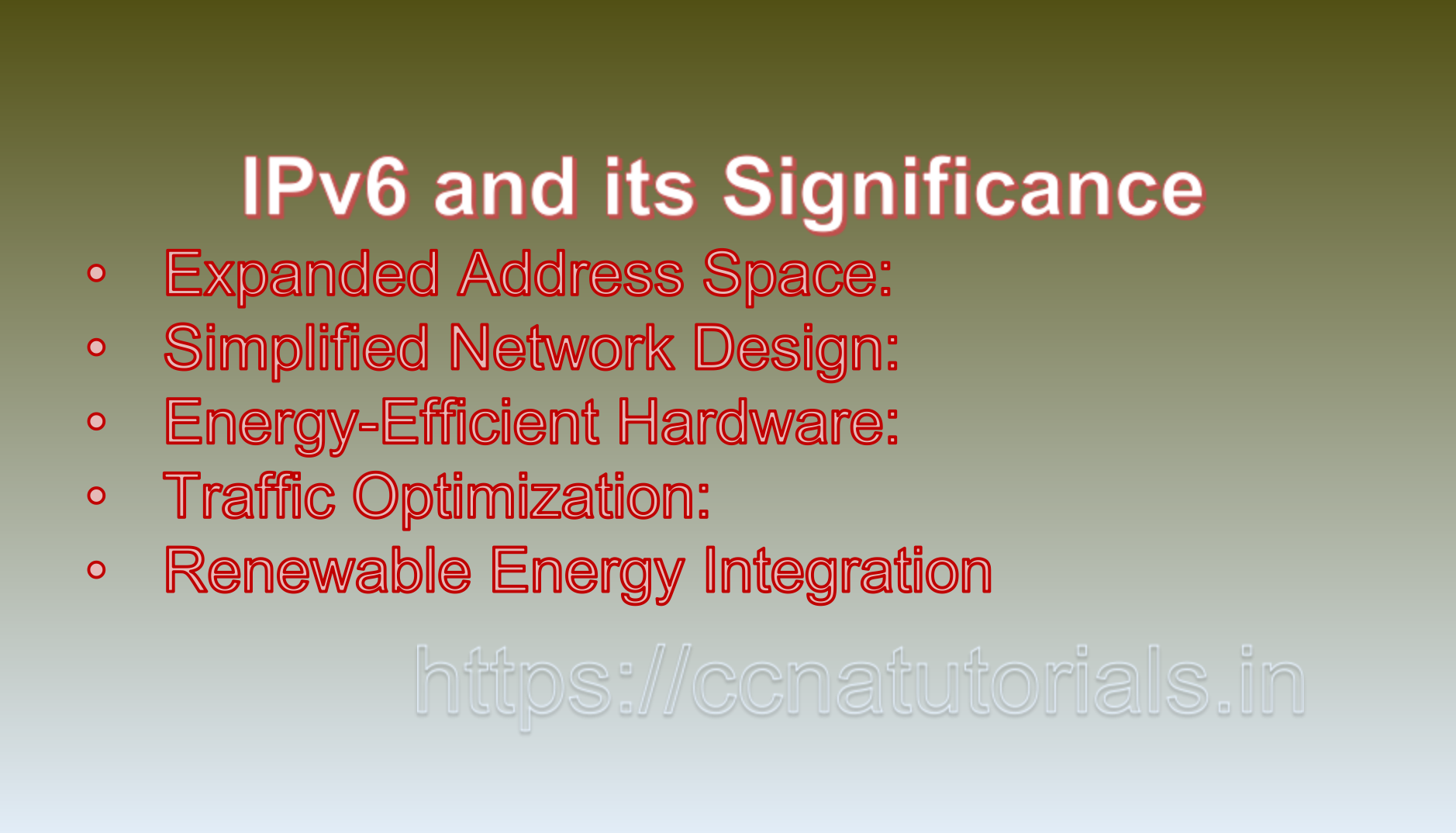Contents of this article
In this article, I describe IPv6 and Energy Efficiency: Creating a Sustainable Digital Landscape. In an era characterized by increasing digitalization and connectivity, the demand for energy to power internet infrastructure is growing significantly. Internet Protocol version 6 (IPv6) and energy efficiency initiatives have emerged as critical solutions to address both the expanding need for unique IP addresses and the environmental impact of energy consumption. This article delves into the relationship between IPv6 and energy efficiency, highlighting how the adoption of IPv6 can contribute to a more sustainable digital landscape.
1. Understanding IPv6 and its Significance:
IPv6 is the latest iteration of the Internet Protocol, designed to succeed IPv4 due to its limitations in available IP addresses. IPv6 introduces several key features that make it a vital component in achieving energy efficiency:
– Expanded Address Space: IPv6’s larger 128-bit address space enables the allocation of an almost infinite number of unique IP addresses. This eliminates the need for resource-intensive workarounds like Network Address Translation (NAT), leading to reduced energy consumption.
– Simplified Network Design: IPv6’s hierarchical addressing structure simplifies routing, allowing for more efficient use of network devices and fewer routing table entries. This streamlined routing contributes to energy savings.
– Autoconfiguration: IPv6 incorporates stateless address autoconfiguration, reducing the need for manual configuration of devices. This automation optimizes resource utilization and minimizes administrative effort, leading to energy-efficient operations.
2. Energy Efficiency in Networking:
Energy efficiency in networking involves minimizing power consumption while maintaining or improving performance. This principle aligns with green networking practices and has a direct impact on both operational costs and environmental sustainability. Key strategies for achieving energy efficiency include:
– Energy-Efficient Hardware: Employing energy-efficient network devices, such as switches and routers, reduces power consumption without compromising performance. Modern hardware often includes features like adaptive power management to dynamically adjust energy consumption based on demand.
– Traffic Optimization: Efficient traffic management and routing algorithms can minimize the time and resources required to transmit data. This optimization reduces energy waste associated with unnecessary data transmission.
– Virtualization and Consolidation: Network function virtualization (NFV) and server virtualization allow multiple services to run on fewer physical devices. This consolidation optimizes resource utilization and reduces the energy footprint of network operations.
– Renewable Energy Integration: Integrating renewable energy sources, such as solar or wind power, into data center operations and networking infrastructure contributes to sustainability by reducing reliance on non-renewable energy.
3. IPv6’s Role in Enhancing Energy Efficiency:
IPv6’s inherent characteristics and functionalities align with the goals of energy-efficient networking:
– Address Space and Growth: IPv6’s vast address space accommodates the growing number of devices, without straining network resources or relying on power-intensive NAT mechanisms.
– Efficient Routing: IPv6’s simplified header structure leads to optimized routing, reducing processing overhead on networking devices and resulting in energy savings.
– Autoconfiguration and Resource Optimization: IPv6’s autoconfiguration eliminates the need for manual IP address assignments, streamlining network management and reducing administrative energy costs.
4. Examples of IPv6 and Energy Efficiency in Practice:
– Korea Telecom (KT): KT, a South Korean telecommunications provider, deployed IPv6 to address the limitations of IPv4 and support the growth of connected devices. This transition led to improved energy efficiency due to the reduction in NAT-related processing demands and streamlined routing.
– AT&T: AT&T, a leading telecommunications company, embraced IPv6 deployment to enable the growth of IoT devices and services. This adoption aligns with the company’s broader sustainability goals, as efficient IoT connectivity reduces the energy required to power and manage devices.
– University of New Hampshire InterOperability Laboratory (UNH-IOL): UNH-IOL, a testing facility for networking technologies, actively promotes IPv6 adoption and energy efficiency. By providing IPv6 testing services and facilitating interoperability, the lab contributes to the wider adoption of IPv6 and its energy-efficient attributes.
In short IPv6 and Energy Efficiency
The convergence of IPv6 and energy efficiency principles represents a significant step toward building a sustainable digital future. As the demand for internet-connected devices continues to rise, energy consumption becomes a critical concern. IPv6’s streamlined design, address space abundance, and autoconfiguration capabilities align with energy-efficient networking practices, enabling organizations to reduce their carbon footprint while supporting innovation and connectivity.
The transition to IPv6 not only addresses the limitations of IPv4 but also serves as a catalyst for energy-efficient networking practices. By optimizing resource utilization, reducing the reliance on energy-intensive mechanisms, and streamlining network operations, IPv6 contributes to a more sustainable and environmentally conscious digital ecosystem. As industries and organizations adopt IPv6, they contribute to the vision of a greener, more efficient, and interconnected world that balances technological advancement with responsible resource consumption.

IPv6 and Energy Efficiency: Paving the Way for Sustainable Networking
As the world becomes increasingly digital, the energy consumption associated with networking infrastructure and operations has become a significant concern. Internet Protocol version 6 (IPv6) offers a unique opportunity to address both the limitations of the older IPv4 protocol and the energy efficiency challenges of modern networking. This article delves into the relationship between IPv6 and energy efficiency, highlighting how the adoption of IPv6 can contribute to more sustainable networking practices.
1. Understanding IPv6 and Energy Efficiency:
IPv6 is the next-generation internet protocol designed to overcome the limitations of IPv4, primarily the exhaustion of available IP addresses. In addition to providing a larger address space, IPv6 introduces several features that align with energy efficiency principles:
– Simplified Header Structure: IPv6’s streamlined header reduces processing overhead in network devices, leading to improved energy efficiency. The simplified header design requires fewer computational resources for routing and handling data packets.
– Optimized Routing: IPv6’s hierarchical addressing and simplified routing headers facilitate more efficient routing algorithms. This optimization minimizes the energy expended by routers and switches when forwarding traffic across the network.
– Autoconfiguration: IPv6 incorporates stateless address autoconfiguration, enabling devices to assign themselves IP addresses without manual intervention. This self-configuration reduces the need for continuous administrative input and minimizes operational energy consumption.
– Security Integration: IPv6 mandates the inclusion of IPsec for secure communication. While enhancing security, IPsec also streamlines the process by which data is encrypted and decrypted, reducing the energy required for securing network traffic.
2. Energy Efficiency in Networking: A Crucial Imperative:
Energy efficiency in networking involves strategies and practices aimed at minimizing power consumption, reducing carbon emissions, and optimizing the use of network resources. As digitalization accelerates, the energy consumption of data centers, network equipment, and communication protocols has raised concerns about environmental sustainability. Key aspects of energy-efficient networking include:
– Reduced Network Overhead: IPv6’s simplified header structure and optimized routing algorithms contribute to decreased network overhead, leading to faster data transmission and reduced energy consumption.
– Green Data Centers: Data centers play a crucial role in network operations. Green data centers leverage energy-efficient technologies, such as advanced cooling systems and renewable energy sources, to minimize power consumption.
– Virtualization and Consolidation: Network virtualization and consolidation involve running multiple virtual instances on a single physical device. This approach optimizes resource utilization, leading to energy savings by reducing the need for additional hardware.
– Dynamic Power Management: Networking devices can dynamically adjust their power consumption based on demand. This feature reduces energy consumption during periods of low traffic, contributing to energy efficiency.
3. IPv6 and Energy Efficiency in Action:
– European Commission’s IPv6 Initiative: The European Commission recognized the potential of IPv6 to drive energy efficiency and sustainability. By promoting IPv6 adoption and providing resources to support its implementation, the commission aimed to accelerate the deployment of energy-efficient networking solutions across Europe.
– Greening the Internet of Things (IoT): The IoT relies on connectivity and data exchange among countless devices. IPv6’s scalability and energy-efficient design are well-suited for accommodating the massive influx of IoT devices. IPv6’s efficient routing and autoconfiguration contribute to energy savings, making it an ideal protocol for greening the IoT ecosystem.
– IPv6 Adoption and Data Center Efficiency: Organizations that adopt IPv6 often experience improved operational efficiency. For instance, IPv6’s streamlined routing mechanisms can lead to reduced congestion and more effective use of data center resources, resulting in energy savings.
4. Case Study: Google’s IPv6 Implementation and Data Center Efficiency:
Google, a technology giant, is committed to both IPv6 adoption and energy-efficient networking practices. Google’s approach to IPv6 implementation aligns with its focus on sustainability:
Success Factors:
– IPv6 Implementation: Google offers its services over both IPv4 and IPv6, ensuring that users can access its resources using the latest protocol. This dual-stack approach demonstrates Google’s commitment to embracing the benefits of IPv6.
– Energy-Efficient Data Centers: Google’s data centers are renowned for their energy-efficient design and operation. The company invests in advanced cooling techniques, renewable energy sources, and innovative hardware architectures to minimize energy consumption.
Impact:
Google’s IPv6 implementation contributes to the growth of IPv6 traffic on the internet. By providing services over IPv6, Google encourages the adoption of the protocol and supports the transition to more energy-efficient networking practices. Additionally, Google’s energy-efficient data centers showcase the tangible benefits of sustainable networking infrastructure.
Conclusion for IPv6 and Energy Efficiency, Striving for a Greener Digital Future:
IPv6’s energy-efficient design and features align well with the imperative to reduce energy consumption in networking. As the world grapples with the challenges posed by climate change and energy scarcity, adopting IPv6 can play a pivotal role in driving energy-efficient networking practices. By simplifying network structures, optimizing routing, and promoting secure communication, IPv6 not only addresses the limitations of IPv4 but also contributes to a more sustainable and environmentally responsible digital ecosystem. As organizations and service providers transition to IPv6, they are taking steps toward a greener future where innovation and energy efficiency coexist for the benefit of the planet and society at large.






